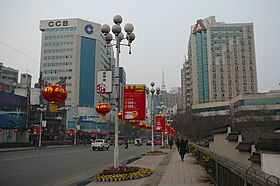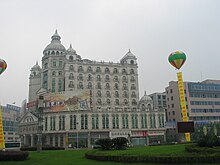Luzhou
| Lúzhōu Shì 泸州 市 Luzhou |
||
|---|---|---|

|
||
|
|
||
| Coordinates | 28 ° 54 ' N , 105 ° 27' E | |
 Location of Luzhou (yellow) in Sichuan |
||
| Basic data | ||
| Country | People's Republic of China | |
| region | Southwest China | |
| province | Sichuan | |
| ISO 3166-2 | CN-SC | |
| status | District-free city | |
| structure | 3 city districts, 4 districts | |
| height | 262 m | |
| surface | 982 km² | |
| Metropolitan area | 12,234 km² | |
| Residents | 919,832 (2010) | |
| Metropolitan area | 4,218,427 | |
| density | 936.7 Ew. / km² | |
| Metropolitan area | 344.8 Ew. / km² | |
| Post Code | 646000 | |
| Telephone code | +86 (0) 830 | |
| Time zone | China Standard Time (CST) UTC +8 |
|
| License Plate | 川 E | |
Luzhou ( Chinese 泸州 市 , Pinyin Lúzhōu Shì ) is a city in the southeast of the Chinese province of Sichuan . It is located at the confluence of the Yangtze and Tuo Jiang (沱江). Luzhou has an area of 12,232 km² and at the end of 2018 had around 5,096,100 registered inhabitants in 1,568,300 million households. Of these, 3,021,900 people belonged to the rural population and 2,074,200, i.e. 40.7%, to the urban population.
history
During the spring and autumn annals (722–481 BC), the area of Luzhou belonged to the Ba tribal union until it was in 316 BC. BC, during the Warring States Period , was conquered by Qin State . In the same year King Huiwen established the Ba (巴郡, Bājùn ) commandant's office there , to which today's Jiangyang district belonged. In 151 BC Jiangyang County was established there during the Western Han Dynasty . The name "Luzhou" appears for the first time at the beginning of the Liang Dynasty , when Emperor Xiao Yan established prefectures (州, zhōu ) across the country between 535 and 546 . When the Mongols invaded today's Sichuan towards the end of the Southern Song Dynasty (1127–1279), the seat of government in Lu Prefecture was relocated to Hejiang County , then to Jiang'an , bordering southwest of the city , and then back to Hejiang until the prefecture finally fell in 1277 after 34 years of defensive fighting. After the Ming dynasty came to power in 1368, Luzhou was directly subordinated to Sichuan Province in 1373, a status that has in principle been maintained to this day. Only during the Republic period from 1913 to 1949, Luzhou was demoted to county for several decades.
Administrative structure
The district-free city of Luzhou is composed of three districts and four districts. These are:
- Jiangyang District - 江阳区Jiāngyáng Qū , the city's seat of government;
- Naxi District - 纳溪 区Nàxī Qū ;
- District Longmatan -龙马潭区Lóngmǎtán Qū ;
- Lu County - 泸 县Lú Xiàn ;
- District Hejiang -合江县Hejiang Xiàn ;
- Circle Xuyong -叙永县Xùyǒng Xiàn ;
- Gulin County - 古蔺县Gǔlìn Xiàn .
Attractions
The old liquor distillery of Luzhou ( Luzhou daqu laojiaochi 泸州 大曲 老 窖 池) has been on the list of monuments of the People's Republic of China (4-249) since 1996 .
sons and daughters of the town
- Zou Kai (* 1988), Turner
Web links
Individual evidence
- ↑ 泸州 市 2018 年 国民经济 和 社会 发展 统计 公报. In: cnstats.org. April 26, 2019, accessed April 4, 2020 (Chinese).
- ↑ 刘怡: 泸州 市. In: sc.gov.cn. May 31, 2018, accessed April 4, 2020 (Chinese).


